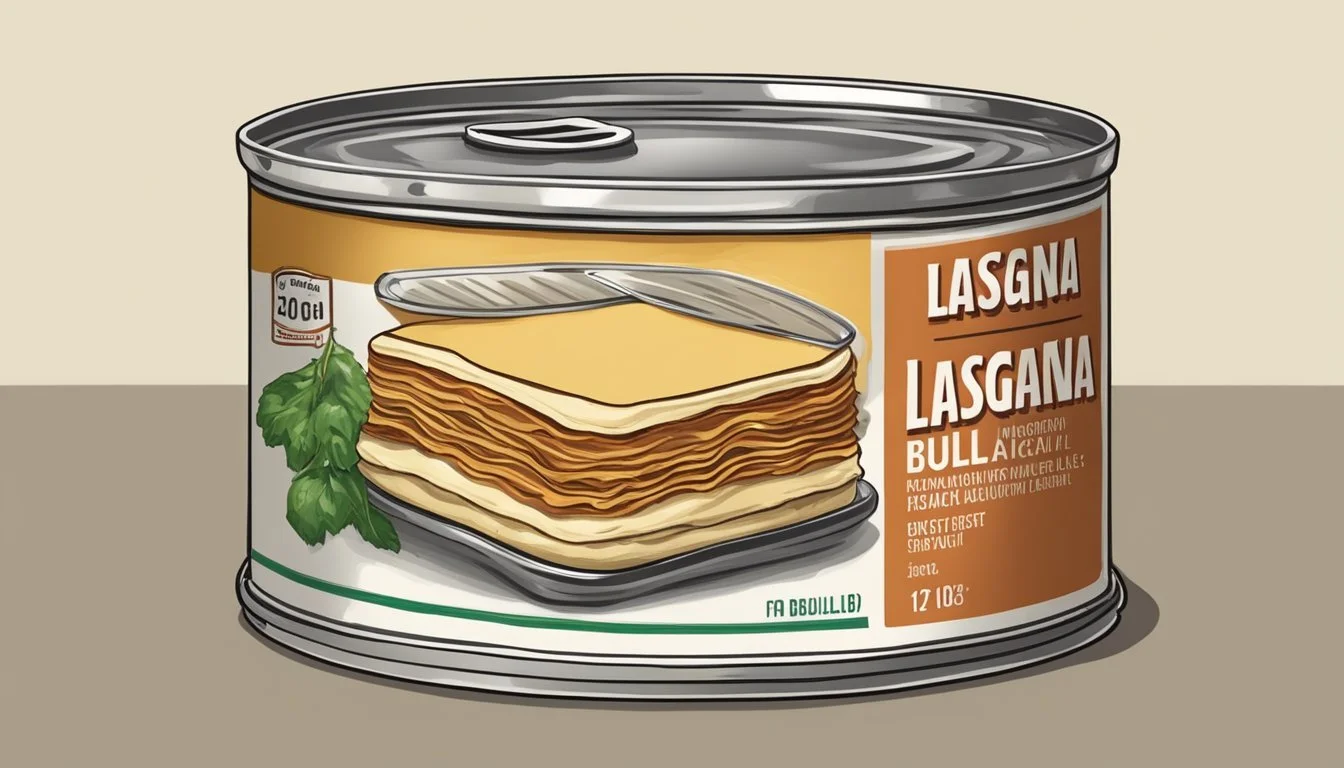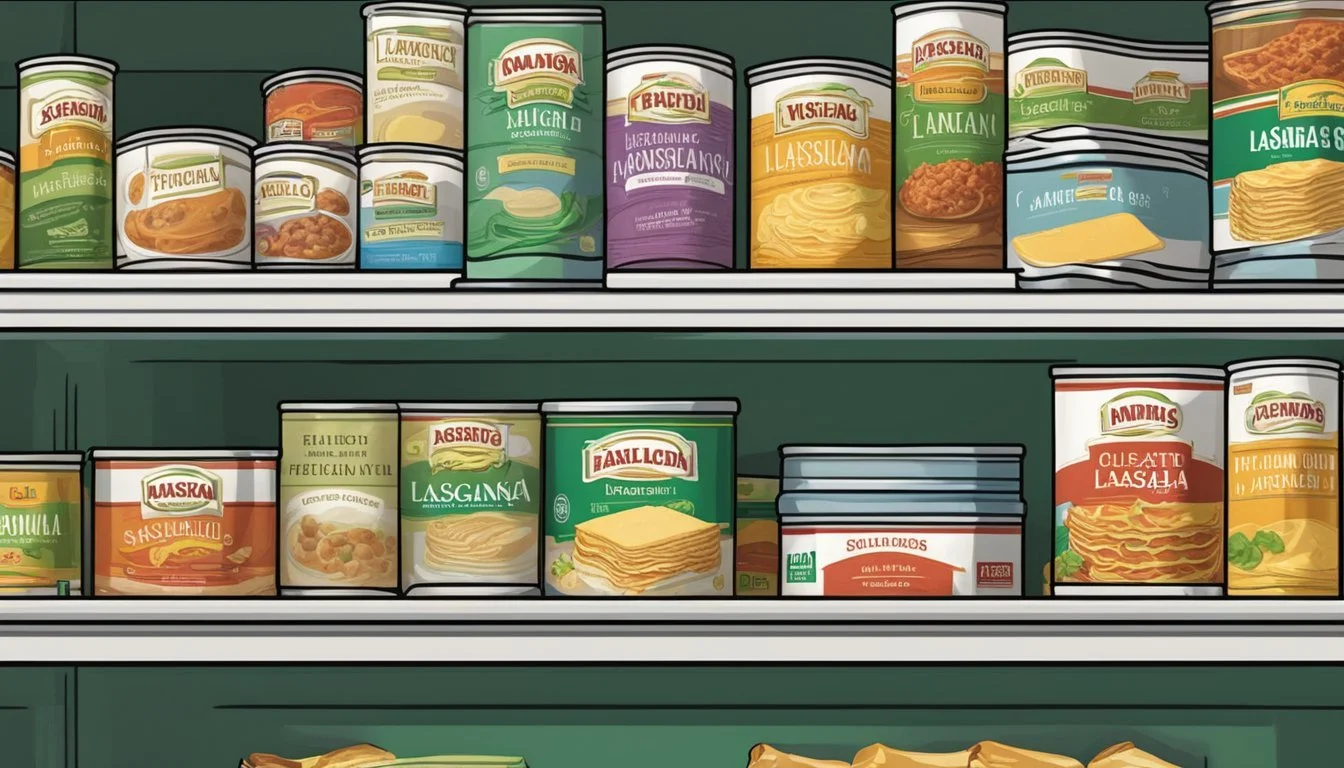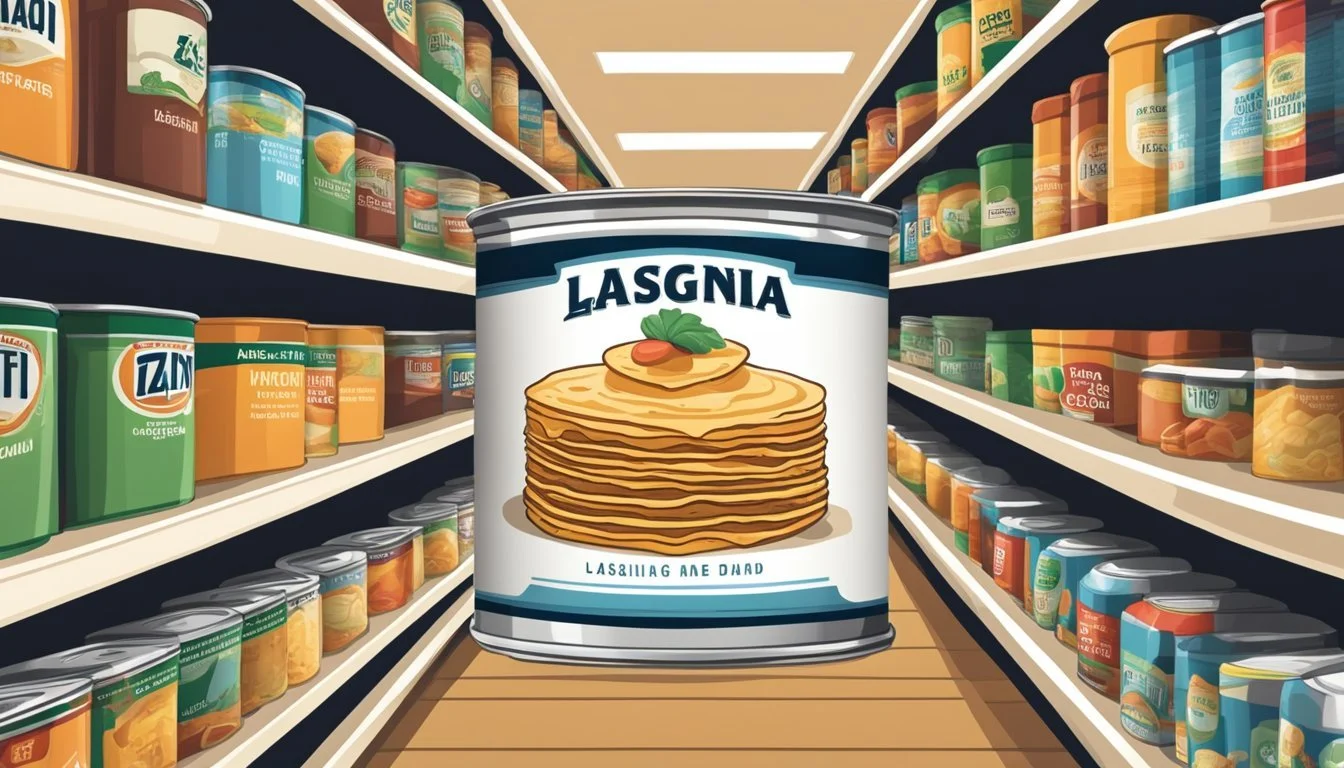Does Canned Lasagna Expire?
Understanding Shelf Life and Safety
When it comes to canned lasagna, many people wonder if this convenient meal option lasts indefinitely. Yes, canned lasagna does expire, but its shelf life can be quite extensive, often lasting 2-5 years when stored in a cool, dry place. This long shelf life makes it a reliable pantry staple for quick and easy meals.
The expiration date printed on the can isn't just an arbitrary number. It’s a key indicator of when the lasagna is expected to maintain its best quality. Consuming canned lasagna past its expiration date may compromise its flavor and texture. Additionally, for food safety, it's crucial to inspect the can for any signs of damage such as rust, dents, or bulging, which could indicate contamination.
To ensure you're getting the most out of your canned lasagna, proper storage and regular checks on the can’s condition are essential. Keeping these factors in mind will help you enjoy safe and delicious meals, even when using canned goods stored for extended periods.
Understanding Expiration Dates
Canned lasagna, like many preserved foods, comes with a variety of date labels that can sometimes be confusing. It's crucial to understand what these dates mean and how they are regulated to ensure food safety and quality.
Decoding Date Labels
Food packaging often includes different date labels such as expiration date, sell-by date, and best before date.
Expiration Date: Indicates the last date recommended for the product's peak quality and safety. After this date, the food may not be safe to consume.
Sell-by Date: Primarily for retailers, this date informs until when the product should be on store shelves. Consumers should use this product within a short time frame after purchase.
Best Before Date: Reflects the best flavor or quality. It is not a safety date. Consuming food past this date may result in diminished taste or texture, but it is often still safe to eat.
Consumers should store canned lasagna properly to extend its shelf life beyond these dates.
Regulations and Guidelines
Various regulations and guidelines control expiration dates on food products.
The USDA (United States Department of Agriculture) provides oversight on food labeling practices to prevent foodborne illnesses and ensure public health. While there are no federal requirements for dating all types of food, stringent guidelines exist for infant formula.
The FDA (Food and Drug Administration) recommends that producers establish dates based on scientific testing to ensure accuracy. These dates must be clear and understandable to consumers. Improper storage can affect these dates' reliability, so the FDA also advises on proper storage techniques.
Being aware of these regulations and guidelines helps consumers make informed decisions about food safety and quality. Proper understanding of these dates can reduce food wastage and ensure consumption of safe, high-quality products.
Food Safety Considerations
Canned lasagna provides a convenient and shelf-stable meal option. However, it's essential to understand the risks and preventive measures to ensure safe consumption.
Risks of Spoiled Foods
Consuming spoiled canned lasagna can lead to serious health problems. Microorganisms like clostridium botulinum produce toxins that cause botulism, a potentially fatal illness. Spoilage signs include unusual smells, bulging can lids, and discolored contents. These signs indicate bacterial contamination.
Botulism in particular is a significant risk because it thrives in low-oxygen environments common in canned foods. Symptoms of botulism include difficulty swallowing, muscle weakness, and respiratory issues. Identifying spoilage is crucial to avoiding these risks.
Prevention of Foodborne Illness
Implementing proper storage and canning techniques can prevent foodborne illnesses from canned lasagna. Always store cans in a cool, dry place to maintain quality and safety. Before consumption, inspect cans for damage or leaks to reduce contamination risk.
Safe canning processes involve high-temperature sterilization to kill bacteria. When home-canning, meticulously follow guidelines to ensure all bacteria, including clostridium botulinum, are eradicated. Additionally, adhering to "best by" dates helps ensure quality and safety.
By following these practices, the risk of illness from consuming canned lasagna can be significantly reduced.
Storing Canned Lasagna Properly
Proper storage of canned lasagna is essential to maintain its quality and safety. Keeping the lasagna in optimal conditions and knowing when refrigeration or freezing is necessary can extend its shelf life.
Optimal Storage Conditions
Canned lasagna should be stored in a cool, dry place, such as a pantry. It is essential to keep the cans away from high temperatures and direct sunlight, both of which can degrade the food quality.
Ideal storage temperatures range between 50°F and 70°F (10°C and 21°C). Extreme temperature fluctuations can cause the can to bulge or rust, indicating possible contamination. Ensure the cans are sealed properly to keep out moisture and pests.
Refrigeration and Freezing
Once opened, any unused portion of canned lasagna should be refrigerated. Transfer the lasagna into an airtight container and store it at or below 40°F (4°C). Consume the refrigerated lasagna within 3-4 days to ensure food safety.
Freezing can extend the shelf life of leftover lasagna. Place lasagna portions into freezer-safe bags or containers, ensuring an airtight seal. Properly frozen lasagna can be stored for 2-3 months. Always label the containers with the date to keep track of the storage time.
Identifying Spoilage in Canned Foods
Recognizing spoilage in canned foods involves observing various physical signs such as bulging, dents, and leaks. Proper identification of these signs can help prevent foodborne illnesses.
Physical Signs of Compromise
Bulging: A bulging can is a clear indicator that gas created by bacterial growth has been trapped. This means the food inside may be spoiled and unfit for consumption. Avoid opening or consuming any food from a bulging can.
Leaking: Leaks suggest that the can's integrity has been compromised. This allows bacteria and other contaminants to enter, increasing the risk of spoilage. If a can shows signs of leakage, it should be discarded immediately.
Dented Cans: Dents, especially those along the seams, can weaken the structure of the can. These weak points can potentially allow bacteria to infiltrate the contents. While not all dented cans have spoiled food, it is safer to inspect them closely.
Rust: Rust on a can means the metal is deteriorating. A rusted can may have tiny holes, potentially allowing air and bacteria to enter. If significant rust is observed, it's best to discard the can to avoid possible spoilage.
When to Discard Canned Goods
Swelling: Swelling is another critical sign of contamination. Cans that appear swollen or have misshaped edges indicate bacterial activity that produces gas. These should be disposed of properly.
Bad Odor: Upon opening, if the food emits a foul or unusual odor, it is likely spoiled. Trust your sense of smell and do not consume food that has an off odor.
Discoloration: Check the color of the food. Any unusual discoloration is a sign that the food might be compromised. Canned foods should retain their expected color, and any deviation can indicate spoilage.
Texture Changes: If the texture appears overly mushy, slimy, or otherwise abnormal, it is a sign that the food may not be safe to eat. These changes usually mean the food quality has deteriorated.
By paying attention to these signs, consumers can effectively identify compromised or potentially hazardous canned foods, ensuring safer consumption practices.
The Impact of Ingredients on Shelf Life
The shelf life of canned lasagna depends significantly on its ingredients. Key factors include the acidity of ingredients like tomatoes and the mix of various components such as meat, vegetables, and pasta.
Acidity and Preservation
Tomatoes are a primary ingredient in lasagna and possess high acidity. This natural acidity helps preserve the lasagna, extending its shelf life significantly.
High-acid foods like tomatoes can last longer than low-acid canned goods due to their preservative properties. High acidity prevents the growth of harmful bacteria, which is essential for long-term storage.
Low-acid canned goods within the lasagna, such as certain types of meat or vegetables, may not last as long. It’s critical to monitor the pH levels of the entire dish to ensure safe storage.
Mix of Ingredients in Lasagna
The combination of ingredients in canned lasagna can affect its longevity. Meat tends to spoil faster than other components. The type of meat (beef, pork, chicken) may also influence shelf life.
Vegetables used in the recipe, especially when they are fresh, can have varying impacts on longevity. Fresh vegetables typically reduce the shelf life compared to canned or preserved equivalents.
Pasta within the lasagna usually has a stable shelf life as it is often processed to last longer. However, moisture content from the sauce and other ingredients can impact its durability.
Balancing these elements ensures that the canned lasagna remains safe and retains quality for an extended period.
Nutritional Value Over Time
Over time, the nutritional value of canned lasagna can change. Key factors influencing nutrient retention include the canning process and storage conditions.
Nutrition Preservation in Canning
Canned foods like lasagna undergo a heat treatment to kill pathogens and seal in nutrients. This process helps preserve the initial nutritional content such as protein, vitamins, and minerals.
Unlike fresh foods, canned lasagna is stored in a sealed environment, minimizing exposure to air and light. This reduces the likelihood of nutrient degradation.
Canning Benefits for Nutrients:
Minimal exposure to oxygen
Long shelf life
Initial nutrients retained post-processing
Changes in Nutritional Content
While canning helps preserve nutritional value, some changes occur over time. Certain vitamins, particularly vitamin C and B vitamins, may degrade during storage. Protein and essential minerals like iron and calcium remain relatively stable.
Factors Influencing Nutrient Degradation:
Storage temperature: Cooler conditions are better
Can integrity: Dents or rust can accelerate nutrient loss
Time: Nutrient quality decreases gradually over years
Protein content in canned lasagna tends to remain consistent. However, a gradual decline in vitamins may affect the overall nutritional profile. This is why consuming canned lasagna within a year or two is recommended for optimal nutrient intake.
Environmental and Economic Perspectives
Examining the environmental and economic implications of canned lasagna expiry can offer valuable insights into food waste management and financial considerations. Focus areas include minimizing waste and the costs associated with discarding food prematurely.
Reducing Food Waste
Canned lasagna, due to its long shelf life, contributes significantly to reducing food waste. Proper storage ensures it remains in good condition for extended periods.
Yet, consumers often discard canned foods prematurely, misinterpreting "best by" dates as strict expiration dates. This leads to unnecessary waste, impacting the environment negatively. Waste reduction efforts can benefit from educational campaigns that focus on understanding these labels and promoting the consumption of food stored correctly, ensuring it remains hygienic and safe to eat.
The Cost of Discarding Food Prematurely
Prematurely discarding canned lasagna has direct economic consequences. Food costs can rise as households replace discarded items more frequently than necessary. Misunderstanding expiration dates leads to edible food being thrown away, affecting both household budgets and the broader economy.
Furthermore, enhancing consumer knowledge about proper food storage and the longevity of canned products can help mitigate these costs. Implementing better practices around food storage ensures lasagna and other canned goods retain their quality, thus reducing unnecessary expenses and conserving financial resources.
Culinary Applications After Expiration
When dealing with canned lasagna past its expiration date, it's crucial to follow safe cooking practices and know how to best utilize these past-date products. Safety and taste are key considerations.
Safe Cooking Practices
Expired canned lasagna can still be safe to eat if proper precautions are taken. Ensure the can is intact, without rust, dents, or swelling.
Experts recommend thoroughly heating the contents to kill any potential bacteria.
It's a good idea to incorporate the lasagna into soups or other dishes that involve cooking at high temperatures. Always taste a small amount first to check for any off flavors.
Leftovers from these preparations should also be stored correctly in airtight containers and consumed within a few days.
Utilizing Past-Date Canned Foods
Canned lasagna that is past its expiration date can add value to many culinary creations. Soups benefit significantly from the addition of canned lasagna to provide a hearty, rich texture.
When added to stews or sauces, it can enhance flavor complexity. Sauerkraut and other fermented foods can be mixed with the lasagna for unique flavor profiles.
Leftovers should be used promptly and reheated to ensure safety. Additionally, experts advise against using past-date lasagna for dishes that won’t be cooked further, like salads.
Be inventive, yet cautious, to ensure both safety and enjoyment.








